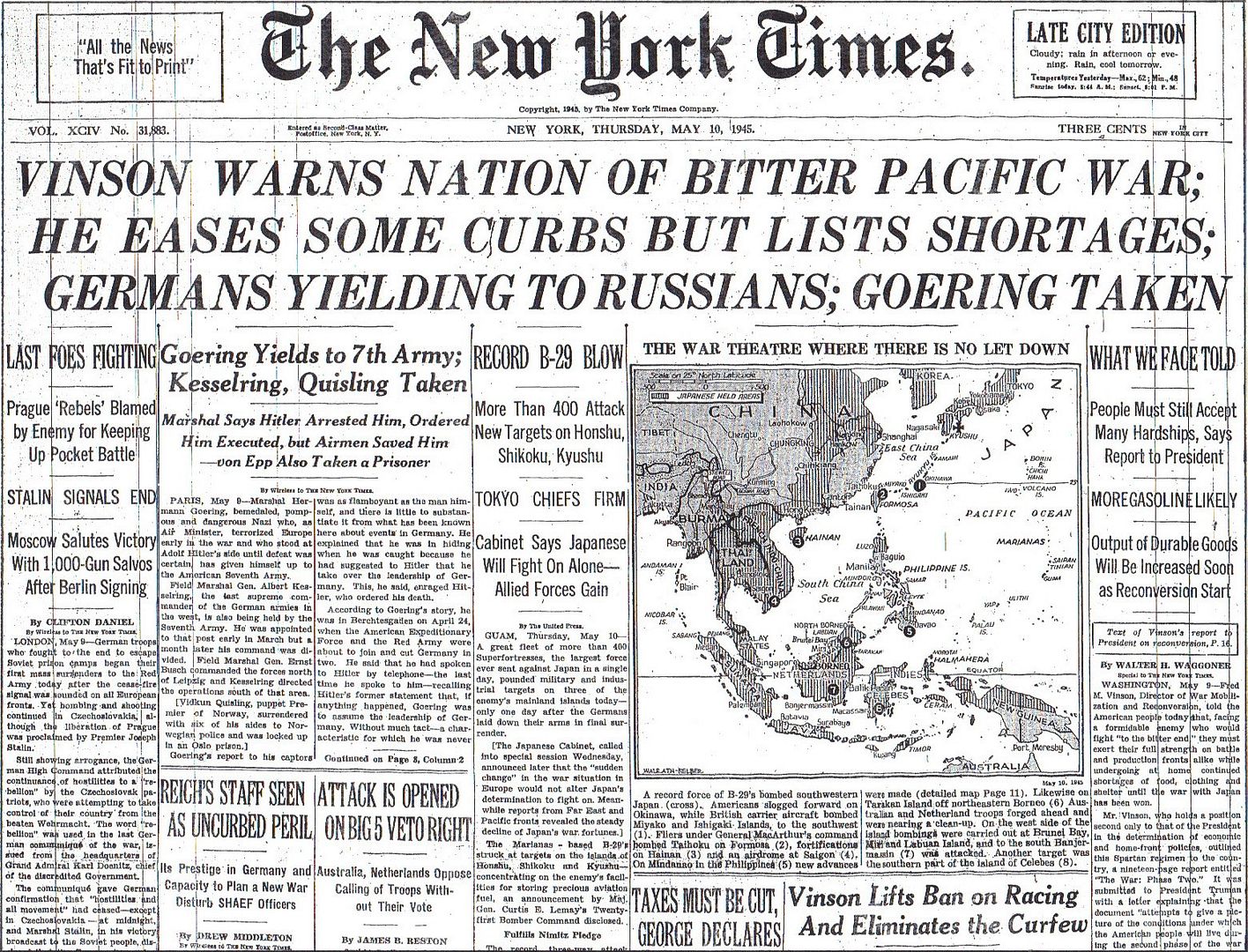
Posted on 05/10/2015 4:45:14 AM PDT by Homer_J_Simpson

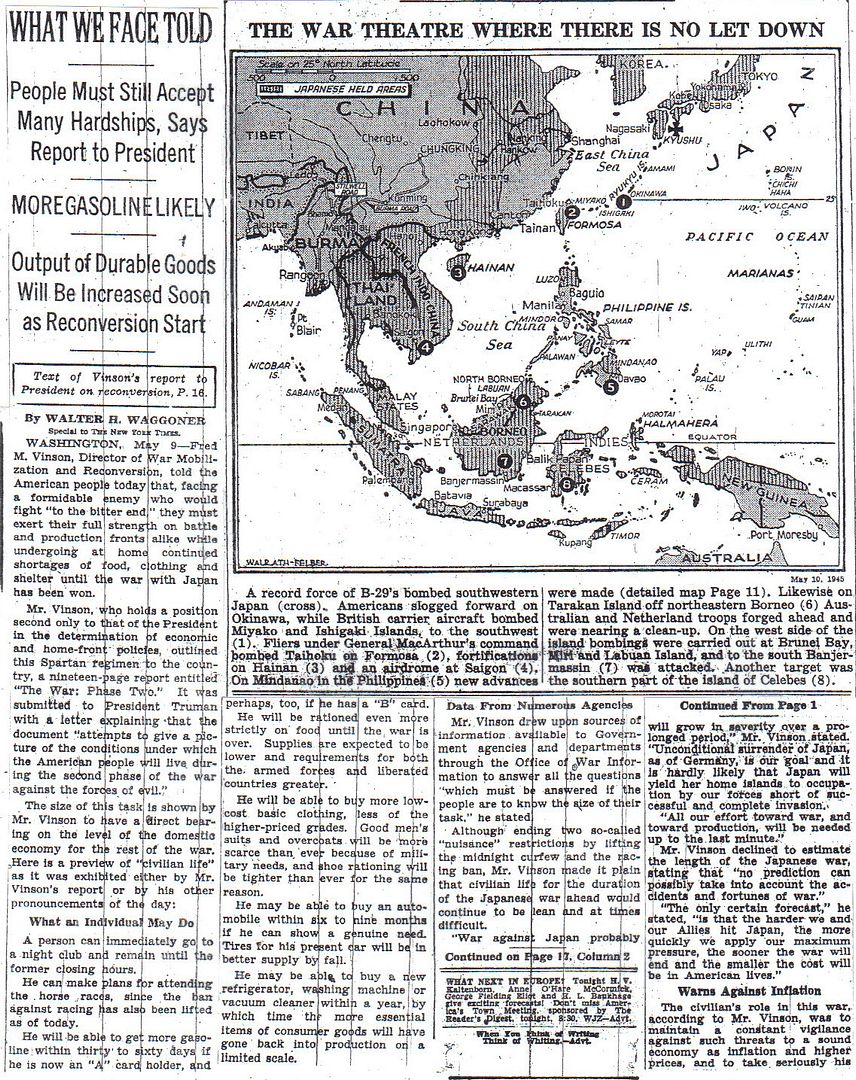
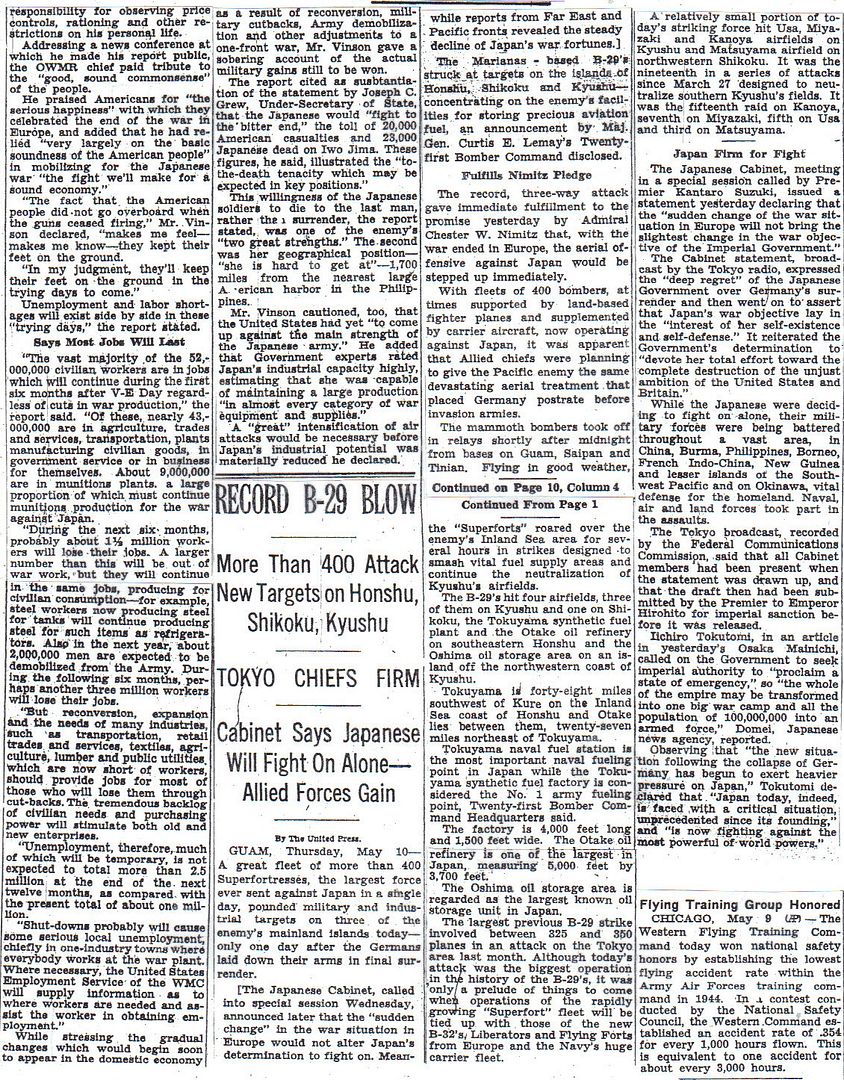
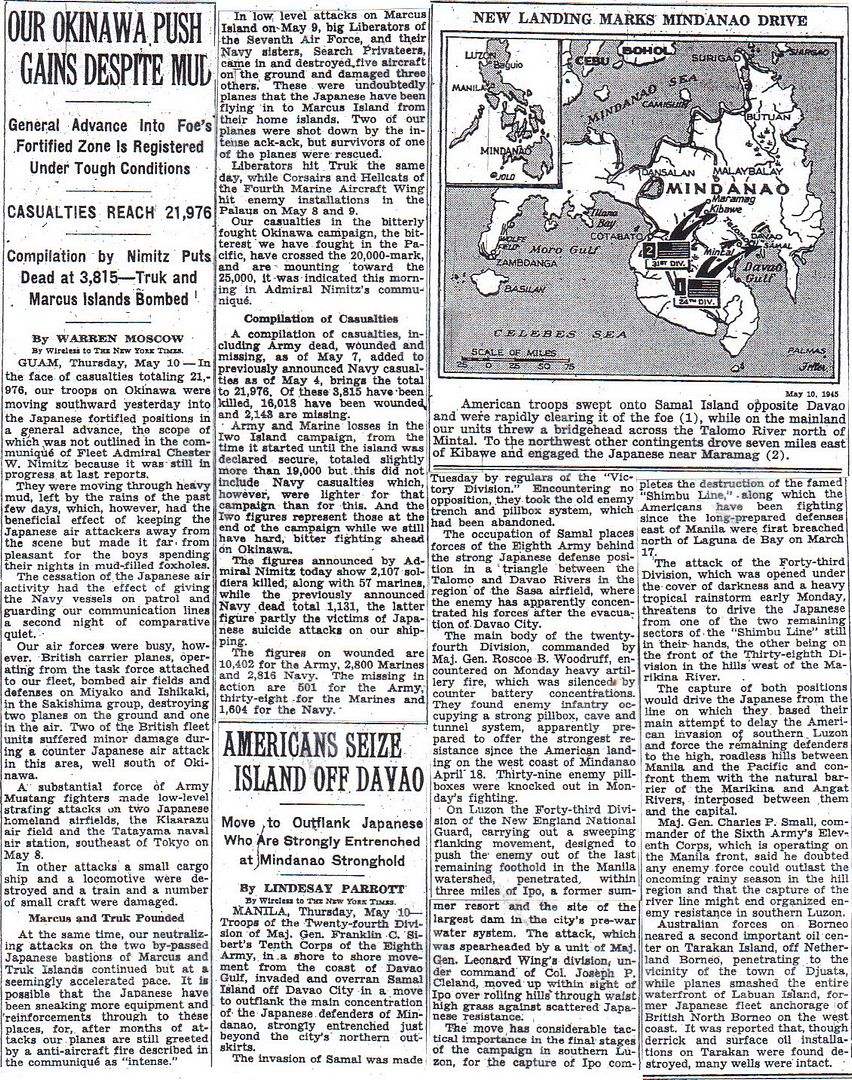
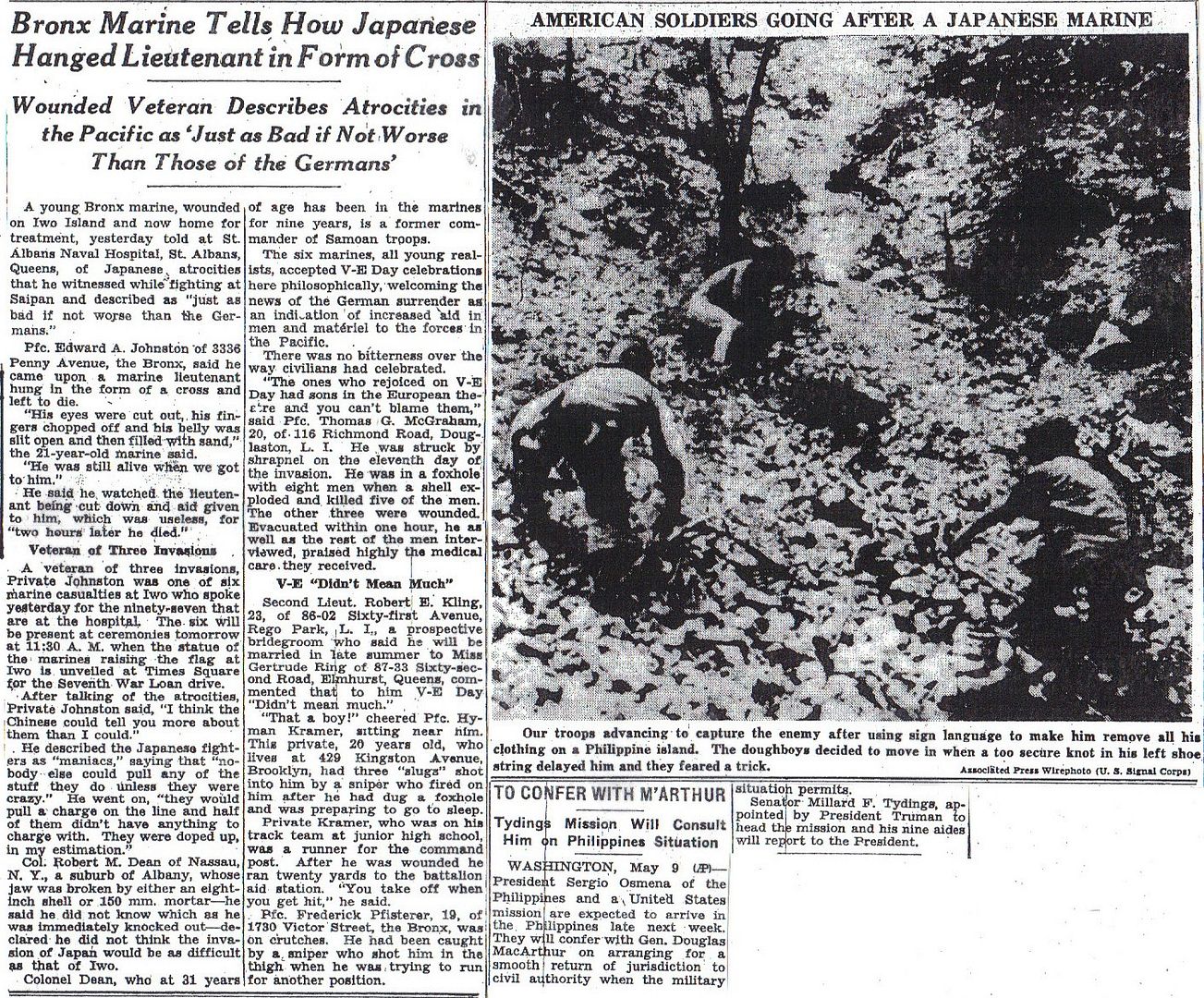
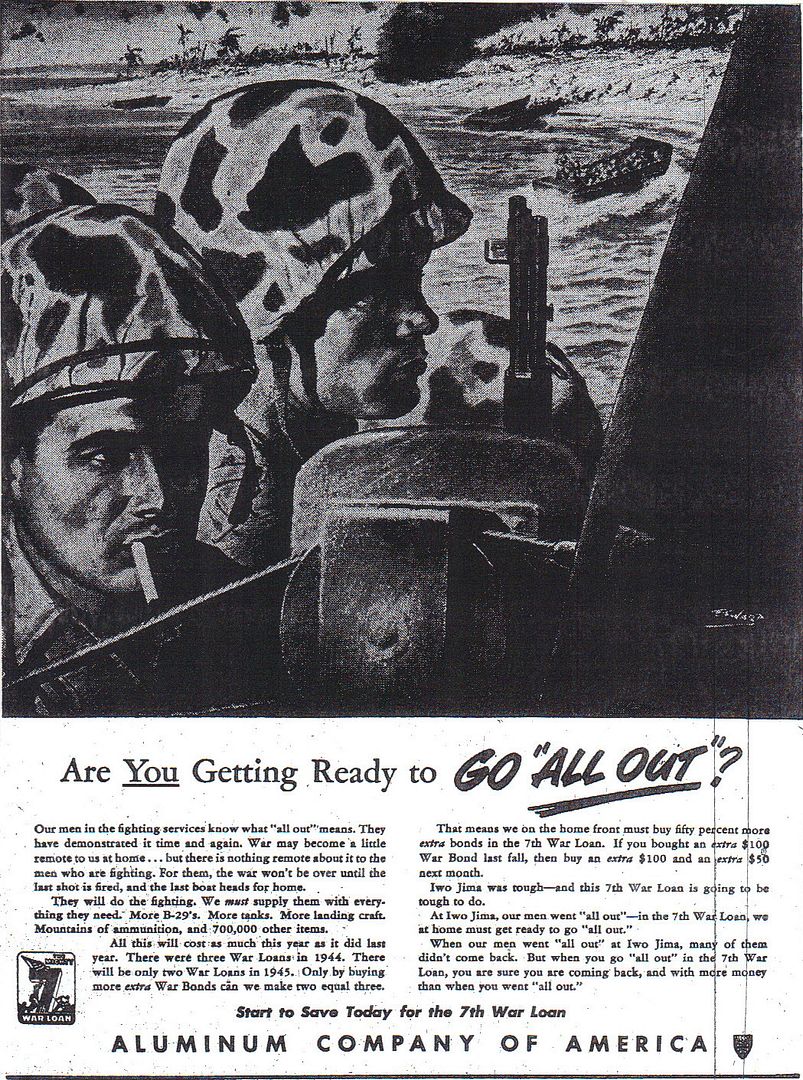
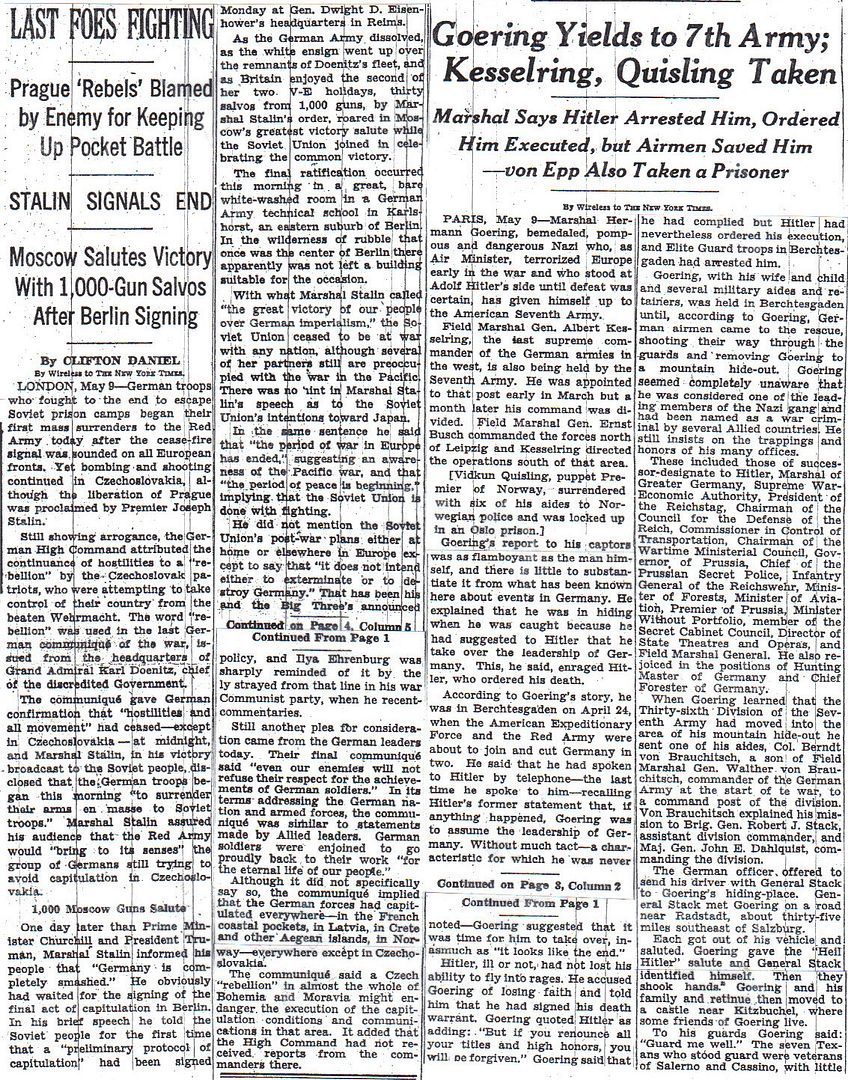
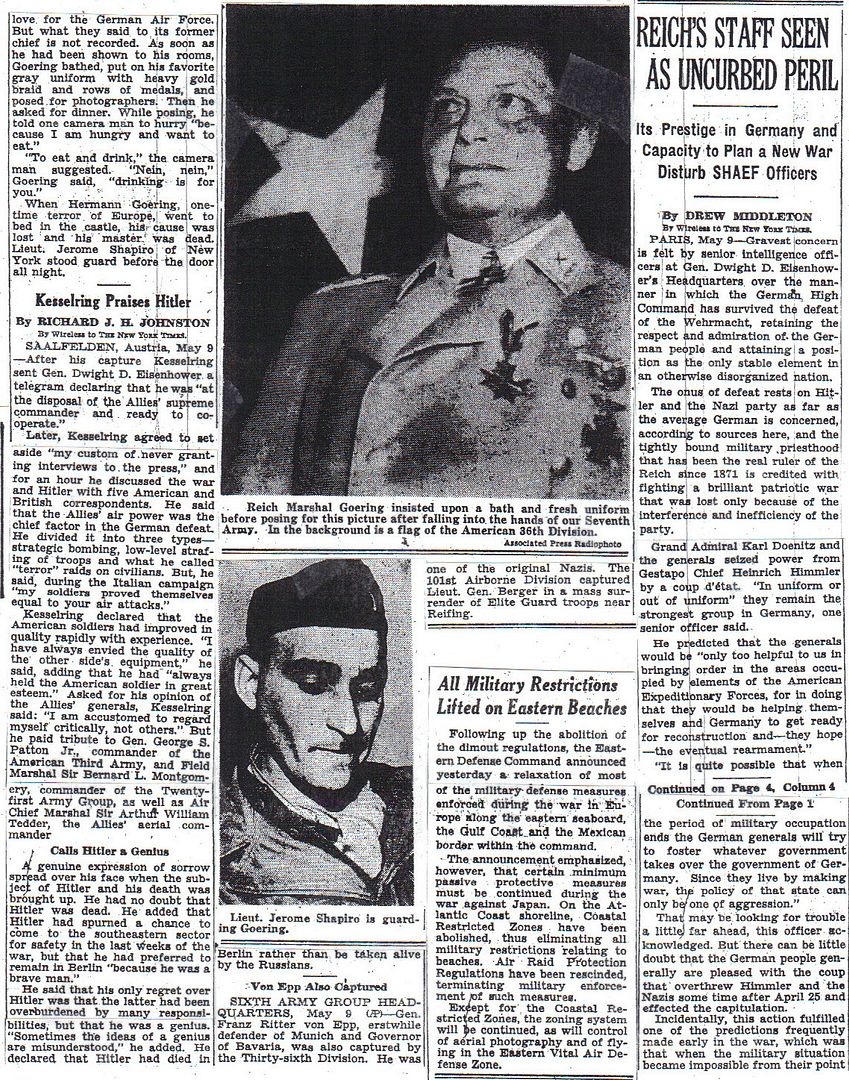
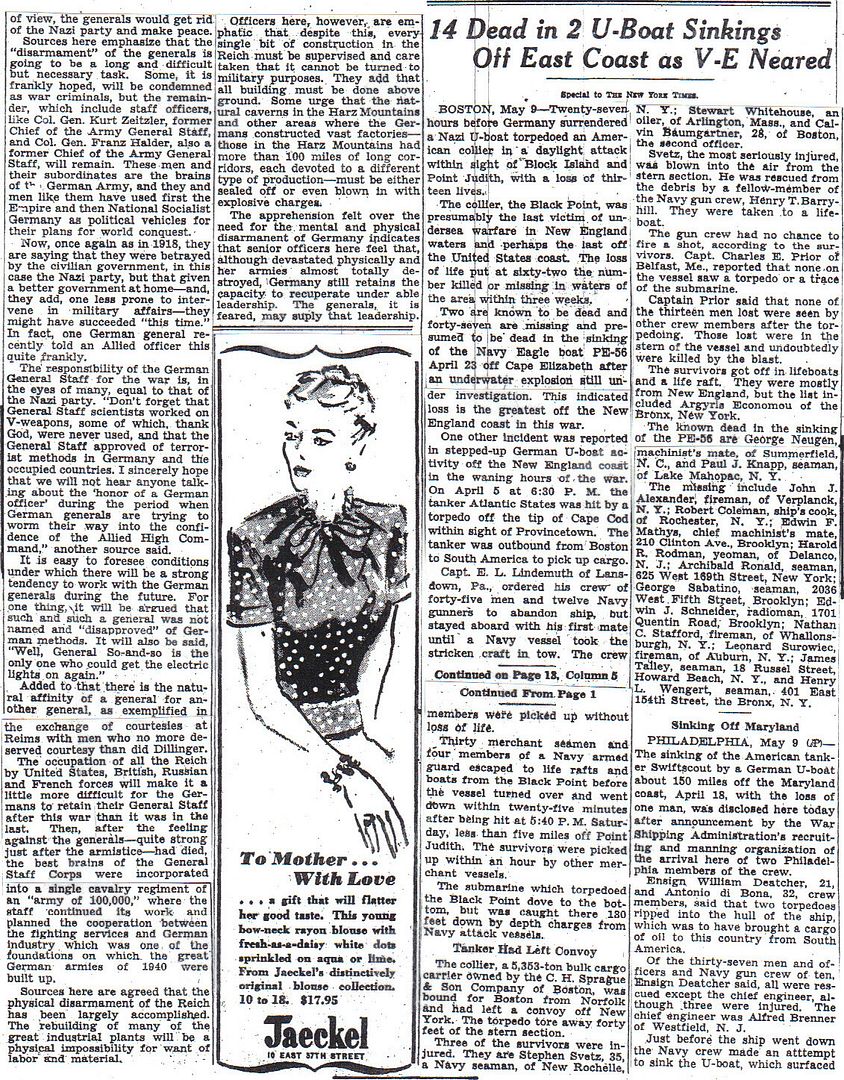
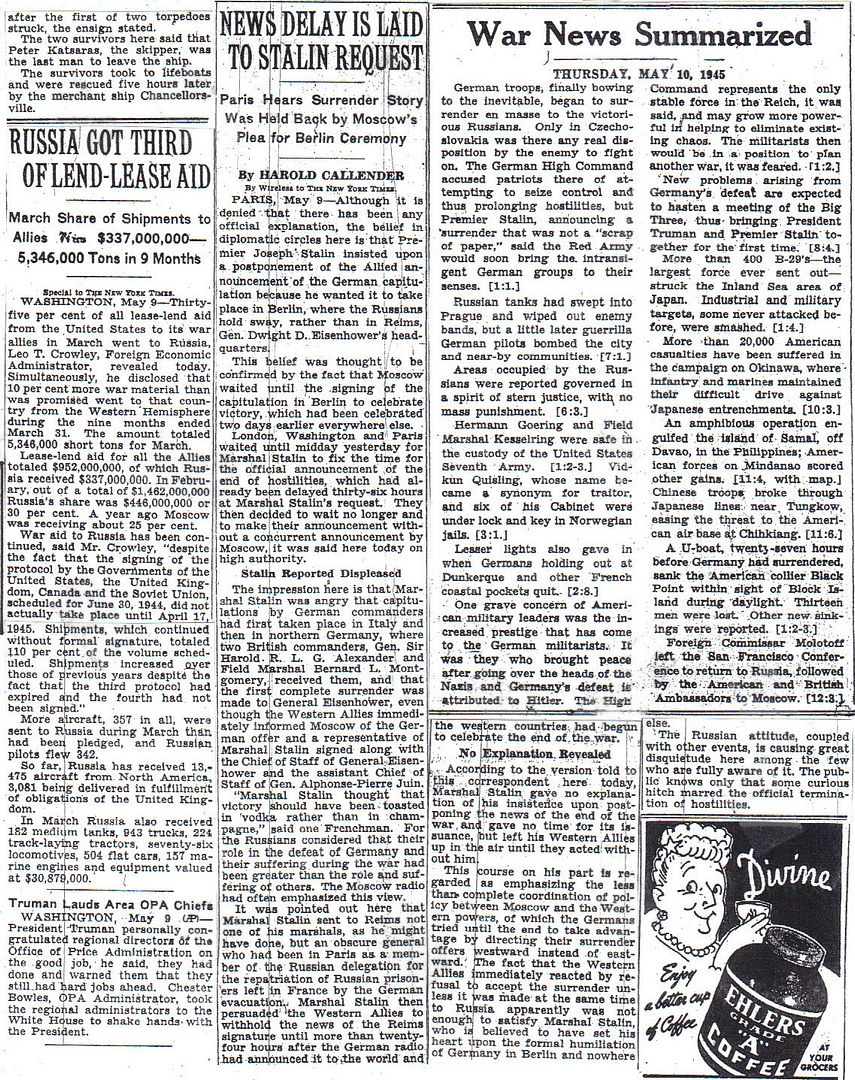
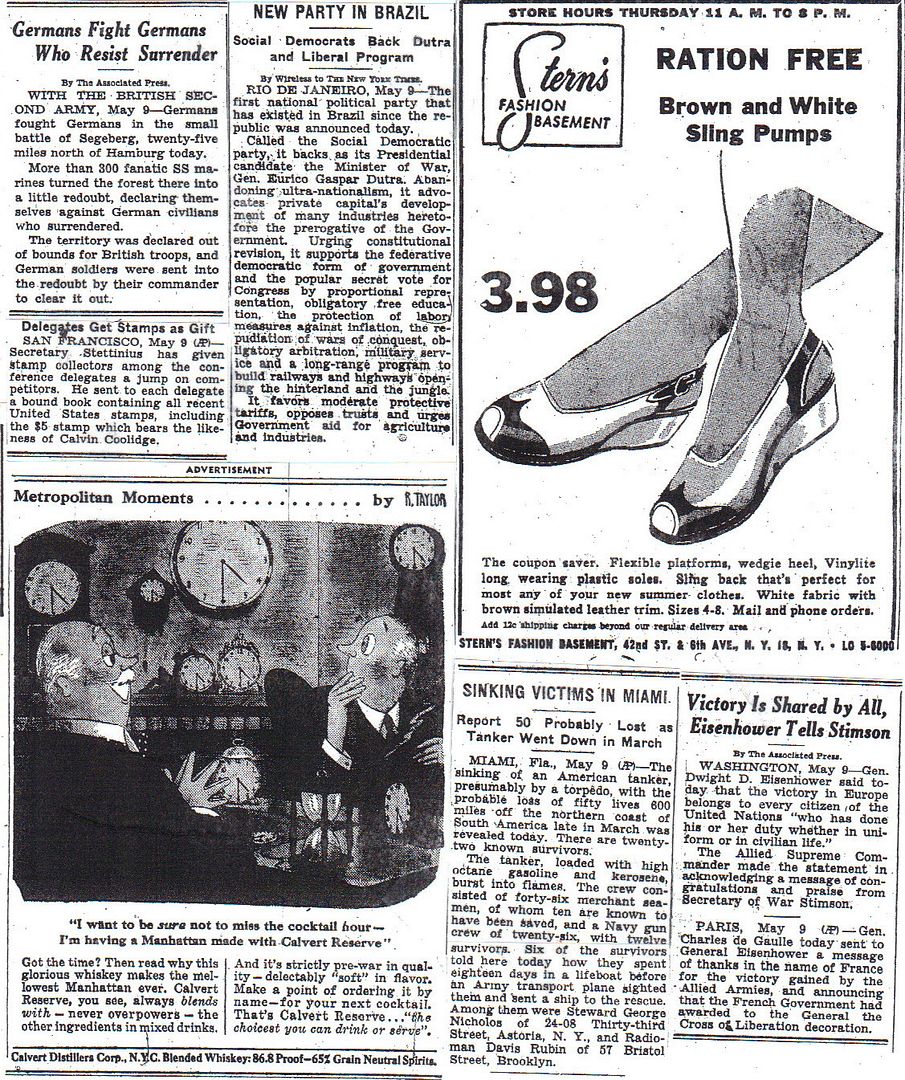
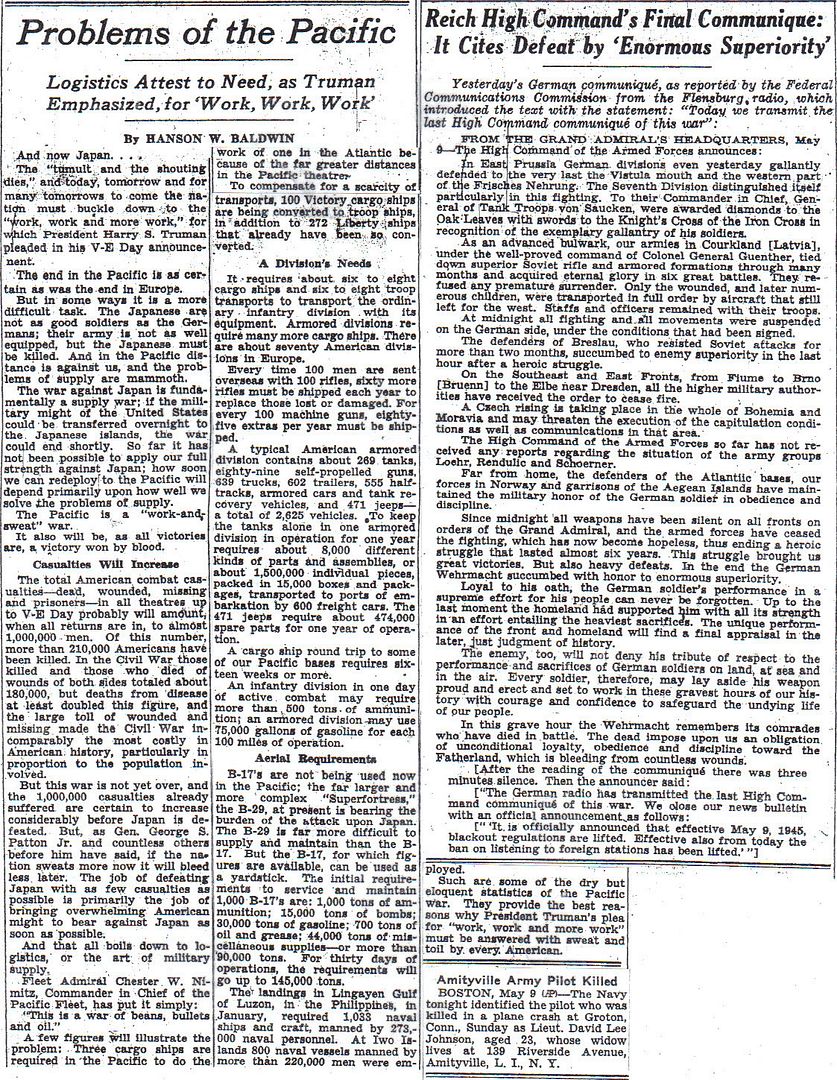


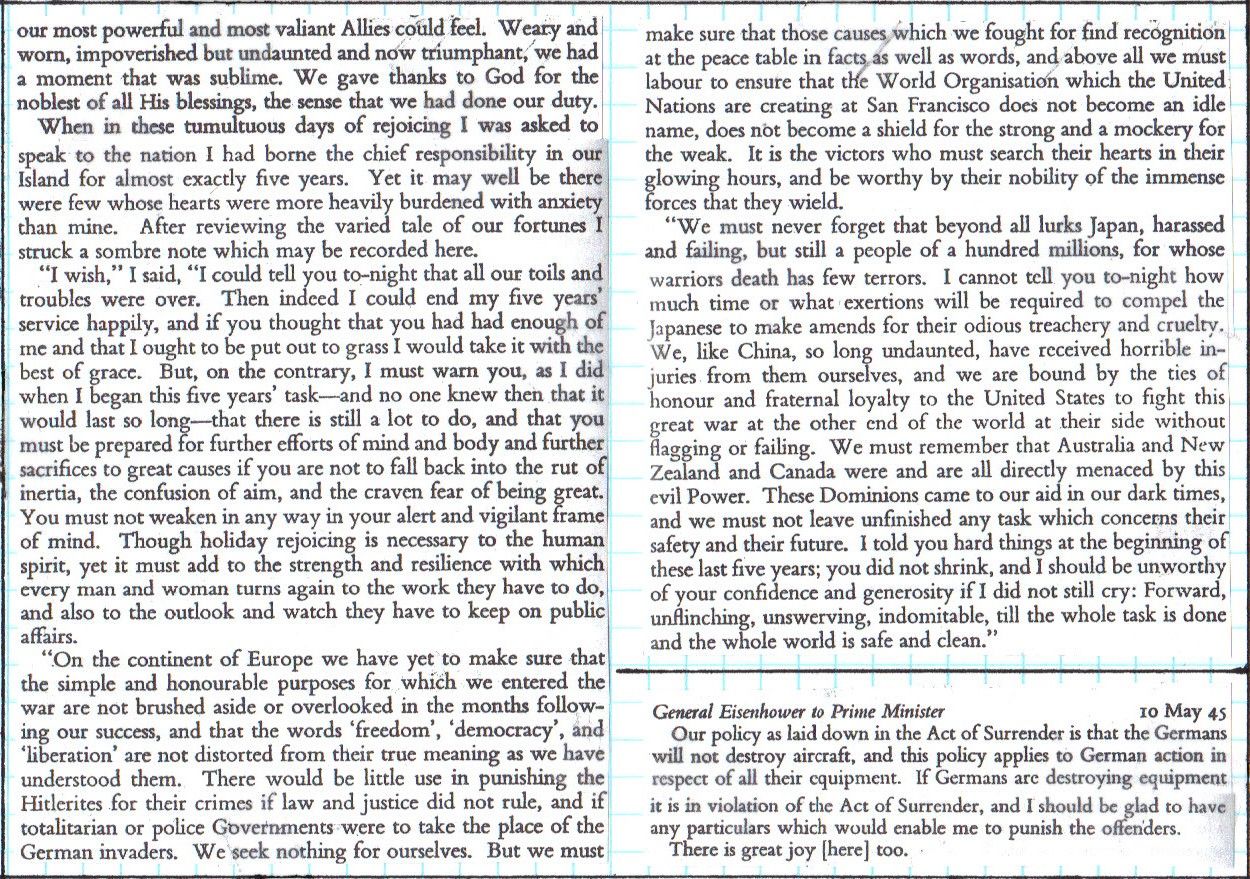
Winston S. Churchill, Triumph and Tragedy
http://www.etherit.co.uk/month/4/10.htm
May 10th, 1945 (THURSDAY)
GERMANY: General Heinz Guderian is taken prisoner by US forces.
NORWAY: Quisling and some supporters are arrested by resistants. They will be held until trial and execution.
Reich Commissar Terboven and the German Chief of Police in Norway commits suicide.
Reichkommissar Joseph Terboven and SS General Riedess blew themselves up in a bunker located in the residence of the Crown Prince, which Terboven had taken over for his own use during the occupation. Jonas Lie, the Norwegian minister of police, and head of the Norwegian SS shot himself dead in a school house in western Oslo, after being surrounded by Milorg men. One Nasjonal Samling member who was a prison director, killed his two children, his wife and himself in fear of what awaited him, and his family. When the prison director’s elderly father heard what had happened, he and his wife took their own lives as well. (Alex Gordon)
The remaining German garrison comprises 312,000 Wehrmacht troops, of which 190,000 are Heer, 75,000 Kriegsmarine (66% of whom are coastal defence troops) and under 50,000 Luftwaffe. Adding the non-Wehrmacht organisations like the SS, Organisation Todt, Transportflotte Speer etc yields another 15-30,000 depending on sources (a footnote in Heibe and Glantz’s “Hitler and his generals” says 29,000) for a grand total of 351,000. (Louis Capdeboscq)
U-977, in Norwegian waters when Germany surrendered, put ashore those men who did not wish to accompany the rest of the crew on a desperate voyage to Argentina.
AUSTRALIA: Air Commodore Cobby, fighter ace of the 1914-1918 War, is relieved of command of the RAAF.
JAPAN: Off Okinawa, kamikazes damage the destroyer USS Brown (DD-546) and light minelayer USS Harry F. Bauer (DM-26).
COMMONWEALTH OF THE PHILIPPINES: The U.S. 108th Regimental Combat Team, 40th Infantry Division, lands unopposed at Macjalar Bay, Mindanao Island. Filipino guerrillas assist in establishing the beachhead.
Coast Guard-manned Army vessel FS-255 had proceeded to Taloma Bay with the Davao Gulf First Re-Supply Echelon with a cargo of 155-mm ammunition on board, for the use of the 24th Division, US Army in their operations against the Japanese. (DS)
CANADA: Minesweeper HMCS Poplar Lake launched New Westminster, British Columbia.
U.S.A.: We also remember the death of Arnold Lloyd Gladson, USMC 2nd Div. (1999)
Destroyer USS Damato laid down.
Destroyer USS Cone launched.
ATLANTIC OCEAN: U-889 surrender, at sea, to RCAF. U-889 hoisted the black flag of surrender to the RCAF Liberator. It took two low passes by the Liberator before the flag went up. They were arming depth charges and setting the bombsight when she made the hoist. The Liberator stood by until RCN ships appeared. U-889 Kptlt Friedrich Braeducker, CO had sailed from Germany by way of Norway in early April. After an uneventful weather ship patrol and at the end of hostilities in accordance with instructions U-889 surfaced and was spotted by an RCAF Liberator some 250 miles SE of Flemish Cap on 10 May 45. Subsequently HMCS Oshawa, Rockcliffe, Saskatoon and Dunvegan intercepted U-889 that day 175 miles SSE of Cape Race. Rockcliffe and Dunvegan were instructed to escort U-889 into Shelburne , Nova Scotia. However, 24hrs after the interception, the 2 ships passed their charge to the frigates HMCS Buckingham and Inch Arran of EG-28 some 140 miles SSE of Sable Island. An “official” surrender of U-889 took place 13 May 45 off the Shelburne Whistle Buoy, 7 miles from the antisubmarine boom gate. HMC ML 121 then escorted U-889 into Shelburne. U-889 was commissioned HMCS U-889 on 14 May 45, for testing and evaluation. Of particular interest were her acoustic torpedoes and highly developed German GHG hydrophone array. U-889 was one of 10 U-boats assigned to the US, as a result “a Canadian steaming crew”. Sailed on 11 Jan 46 for Portsmouth, New Hampshire. U-889 was Paid off 12 Jan 46 and turned over to the USN.
"As Allied forces fought their way closer to concentration camps, German troops and collaborators, SS men assigned to the 'care' of Jews and other prisoners were taken captive in ever-increasing numbers.
The men seen here were photographed after they fell into Allied hands.
Here is Leonhard Eichberger, a death-march SS guard."
"Michael Redwitz, SS guard."
"Konrad Belsh, death-march SS guard."
"Jean Scheibel, a guard, possibly not with the SS."
"Camp guards often executed inmates as the Allied armies approached.
Here, commandant Eichelsdörfer of the Kaufering III concentration camp at Landsberg, Germany, is forced by American liberators to stand amidst the emaciated corpses of hundreds of the camp's victims, many of whom had been shot as the Americans drew near.
Kaufering III was a subcamp of Dachau."
"Camp survivors often sought revenge against their former captors, especially those who had been particularly vicious.
Here, at the camp at Gusen, Austria, a small crowd of liberated prisoners and American soldiers scrutinizes the dead body of a camp guard, who was killed by some of his former charges."
"On June 28, 1941, German forces conquered the Belorussian city of Minsk.
The Germans had killed thousands of its 80,000 ghettoized Jews by mid-autumn, but Masha Bruskina, a 17-year-old girl, was among the Jews who resisted.
The Germans caught her, and she was hanged on October 26.
Starvation, forced labor, shooting, gassing...Nazi Germany destroyed European Jews and millions of non-Jews in many ways, but each person perished one by one.
"Individual deaths multiplied into mind-boggling statistics.
One leading Holocaust scholar, Raul Hilberg, estimates that 5.1 million Jews perished in the Holocaust.
Most scholars now believe that the Jewish death total approached six million.
Israel Gutman and Robert Rozett, for example, put Jewish losses between 5,596,000 and 5,860,000.
German scholar Wolfgang Benz lists the figure at 6.1 million.
The estimates of deaths vary widely for several reasons: the years and geographical boundaries used to determine prewar census data, the margins of error in death reports from German and Jewish sources, the difficulties of comparing prewar and postwar populations, and the fact that the Germans and their collaborators did not record the death of every victim.
"Every reliable judgment finds that nearly two-thirds of the European Jews--and one-third of the Jews in the world--were killed in the Holocaust.
Hitler intended to obliterate all Jewish life--root and branch.
The staggering number of those who indeed met their deaths demonstrates how close he came."
U-977 made it safely to Argentina on August 17. Submarine and crew were turned over to the US.
http://en.wikipedia.org/wiki/German_submarine_U-977
I was shocked to see a marine shown smoking a cigarette on the p6 ad by the American Aluminum Company. The marine could get cancer!
http://www.dannen.com/decision/targets.html
Minutes of the second meeting of the Target Committee
Los Alamos, May 10-11, 1945
Source: U.S. National Archives, Record Group 77, Records of the Office of the Chief of Engineers, Manhattan Engineer District, TS Manhattan Project File ‘42-’46, folder 5D Selection of Targets, 2 Notes on Target Committee Meetings.
TOP SECRET TOP SECRET
Auth: C.O., Site Y, N.M.
Initials:
Date: 12 May 1945
This document consists of 7 Page(s)
No. 1 of 4 Copies, Series A
U-13-XIX-1A
DECLASSIFIED
E.O. 11653, Sec. 3(E) and 5(D) or (6)
NND 730039
By ERC NARS, Date 6-4-74
12 May 1945
Memorandum For: Major General L. R. Groves
Subject: Summary of Target Committee Meetings on 10 and 11 May 1945
1. The second meeting of the Target Committee convened at 9:00 AM 10 May in Dr. Oppenheimer’s office at Site Y with the following present:
General Farrell Dr. C. Lauritsen
Colonel Seeman Dr. Ramsey
Captain Parsons Dr. Dennison
Major Derry Dr. von Neumann
Dr. Stearns Dr. Wilson
Dr. Tolman Dr. Penney
Dr. Oppenheimer
Dr. Bethe and Dr. Brode were brought into the meeting for discussion of Item A of the agenda. During the course of the meeting panels were formed from the committee members and others to meet in the afternoon and develop conclusions to items discussed in the agenda. The concluding meeting was held at 10:00 AM 11 May in Dr. Oppenheimer’s office with the following present:
Colonel Seeman Dr. Stearns
Captain Parsons Dr. Von Neumann
Major Derry Dr. Dennison
Dr. Tolman Dr. Penney
Dr. Oppenheimer Dr. Ramsey
Dr. Wilson
2. The agenda for the meetings presented by Dr. Oppenheimer consisted of the following:
A. Height of Detonation
B: Report on Weather and Operations
C: Gadget Jettisoning and Landing
D: Status of Targets
E: Psychological Factors in Target Selection
F: Use Against Military Objectives
G: Radiological Effects
H: Coordinated Air Operations
I: Rehearsals
J: Operating Requirements for Safety of Airplanes
K: Coordination with 21st Program
3. Height of Detonation
A. The criteria for determining height selection were discussed. It was agreed that conservative figures should be used in determining the height since it is not possible to predict accurately the magnitude of the explosion and since the bomb can be detonated as much as 40% below the optimum with a reduction of 25% in area of damage whereas a detonation 14% above the optimum will cause the same loss in area. It was agreed that fuses should be prepared to meet the following possibilities:
(1) For the Little Boy the detonation heights should correspond to a pressure of 5 psi, a height of the Mach-stem of 100 feet and a magnitude of detonation of either 5,000 or 15,000 tons of H.E. equivalent. With present knowledge the fuse setting corresponding to 5,000 tons equivalent would be used but fusing for the other should be available in case more is known at the time of delivery. The height of detonation corresponding to 5,000 and 15,000 tons are 1550 feet and 2400 feet, respectively.
(2) For the Fat Man the detonation heights should correspond to a pressure of 5 psi, a height of the Mach-stem of 100 feet, and a magnitude of explosion of 700, 2,000, or 5,000 tons of H.E. equivalent. With the present information the fuse should be set at 2,000 tons equivalent but fusing for the other values should be available at the time of final delivery. The heights of detonation corresponding to 700, 2,000, and 5,000 tons are 580 feet, 1,000 feet and 1,550 feet, respectively. Trinity data will be used for this gadget.
B. In the case of the Fat Man delay circuits are introduced into the unit for purposes which make the detonation of the bomb 400 feet below the height at which the fuse is set. For this reason as far as the Fat Man is concerned the fuse settings should be 980 feet, 1,400 feet, or 1,950 feet.
C. In view of the above it was agreed by all present that fuses should be available at four (4) different height settings. These heights are 1,000 feet, 1,400 feet, 2,000 feet and 2,400 feet. With present information the 1,400 feet fuse would be most likely to be used for both the Fat Man and the Little Boy. (Later data presented by Dr. Brode modify the above conclusions on fusing and detonating heights; the differential height for the Little Boy is 210 feet and for the Fat Man 500 feet. For this reason some of the above figures must be revised).
4. Report on Weather and Operations
A. Dr. Dennison reported on the above subject. His report essentially covered the materials in his Top Secret memo of 9 May - Subject: “Preliminary report on Operational Procedures”. For this reason his report will not be repeated here but is attached as an appendix. It was agreed by those present that the mission if at all possible should be a visual bombing mission. For this we should be prepared to wait until there is a good weather forecast in one or more of three alternative targets. There is only a 2% chance in this case that we will have to wait over two weeks. When the mission does take place there should be weather spotter aircraft over each of three alternative targets in order that an alternative target may be selected in the last hour of the flight if the weather is unpromising over the highest priority target.
B. In case the aircraft reaches the target and finds, despite these precautions that visual bombing is impossible, it should return to its base provided that it is in good operating condition. Only if the aircraft is in sufficiently bad shape that it is unlikely that it can return to base and make a safe landing or if it is essential that the drop be made that day should the drop be made with radar equipment. For this purpose it may be desirable to have an Eagle radar equipped plane accompany the mission in order that formation bombing with the Eagle plane in the lead can be made to obtain the increased accuracy from Eagle. A final decision as to the desirablity of this emergency procedure can only be made after further combat experience is obtained with Eagle aircraft. In any case every effort should be made to have the mission such that blind bombing will be unnecessary.
C. It was agreed that Dr. Stearns and Dr. Dennison should keep themselves continuously informed as to radar developments. If at any time new developments are available which show in combat a marked improvement of accuracy the basic plan may be altered.
D. It was agreed that Shoran was a very promising development for the 21st Bomber Command but that we should make no plans to use Shoran until its success is fully confirmed in normal bombing missions in that area.
E. The plan to use the gadget with visual bombing even though this may require a one day to three weeks delay requires that the gadget be such that for a period of at least three weeks it can be held in readiness in such a state that on twelve hours notice it can be prepared for a combat mission. No difficulty in this regard was foreseen by those present.
5. Gadget Jettisoning and Landing
A. It was agreed that if the aircraft has to return to its base with the gadget and if it is in good condition when it has reached there, it should make a normal landing with the greatest possible care and with such precautions as stand-by fire equipment being held in readiness on the ground. This operation will inevitably involve some risks to the base and to the other aircraft parked on the field. However, the chance of a crash when the aircraft is in good condition and the chances of a crash initiating a high order explosion are both sufficiently small that it was the view of those present that the landing operation with the unit under these circumstances was a justifiable risk. Frequent landings with inert and H.E. filled units have been made in the past. Training in landing with the unit should be given to all crews who carry an active unit.
B. In case the aircraft returns to its base and then finds that it cannot make a normal landing it may be necessary to jettison the bomb. In the case of the Fat Man this can probably best be accomplished by dropping the bomb into shallow water from a low altitude. Tests on this will be carried out with both inert and live units. In the case of the Little Boy the situation is considerably more complicated since water leaking into the Little boy will set off a nuclear reaction, and since the American held territory in the vicinity of the base is so densely filled that no suitable jettisoning ground for the Little Boy has been found which is sufficiently devoid of moisture, which is sufficiently soft that the projectile is sure not to seat from the impact, and which is sufficiently remote from extremely important American installations whose damage by a nuclear explosion would seriously affect the American war effort. The best emergency procedure that has so far been proposed is considered to be the removal of the gunpowder from the gun and the execution of a crash landing. In this case there is no danger of fire setting off the gun and the accelerations should be sufficiently small to prevent seating of the projectile by the impact. Tests on the feasibility of unloading the gun powder in flight will be conducted.
C. It was agreed that prior to actual delivery some form of instructions should be prepared as a guide to the senior man on the aircraft as to procedures to be followed in cases of different types of disasters.
6. Status of Targets
A. Dr. Stearns described the work he had done on target selection. He has surveyed possible targets possessing the following qualification: (1) they be important targets in a large urban area of more than three miles in diameter, (2) they be capable of being damaged effectively by a blast, and (3) they are unlikely to be attacked by next August. Dr. Stearns had a list of five targets which the Air Force would be willing to reserve for our use unless unforeseen circumstances arise. These targets are:
(1) Kyoto - This target is an urban industrial area with a population of 1,000,000. It is the former capital of Japan and many people and industries are now being moved there as other areas are being destroyed. From the psychological point of view there is the advantage that Kyoto is an intellectual center for Japan and the people there are more apt to appreciate the significance of such a weapon as the gadget. (Classified as an AA Target)
(2) Hiroshima - This is an important army depot and port of embarkation in the middle of an urban industrial area. It is a good radar target and it is such a size that a large part of the city could be extensively damaged. There are adjacent hills which are likely to produce a focussing effect which would considerably increase the blast damage. Due to rivers it is not a good incendiary target. (Classified as an AA Target)
(3) Yokohama - This target is an important urban industrial area which has so far been untouched. Industrial activities include aircraft manufacture, machine tools, docks, electrical equipment and oil refineries. As the damage to Tokyo has increased additional industries have moved to Yokohama. It has the disadvantage of the most important target areas being separated by a large body of water and of being in the heaviest anti-aircraft concentration in Japan. For us it has the advantage as an alternate target for use in case of bad weather of being rather far removed from the other targets considered. (Classified as an A Target)
(4) Kokura Arsenal - This is one of the largest arsenals in Japan and is surrounded by urban industrial structures. The arsenal is important for light ordnance, anti-aircraft and beach head defense materials. The dimensions of the arsenal are 4100’ x 2000’. The dimensions are such that if the bomb were properly placed full advantage could be taken of the higher pressures immediately underneath the bomb for destroying the more solid structures and at the same time considerable blast damage could be done to more feeble structures further away. (Classified as an A Target)
(5) Niigata - This is a port of embarkation on the N.W. coast of Honshu. Its importance is increasing as other ports are damaged. Machine tool industries are located there and it is a potential center for industrial despersion. It has oil refineries and storage. (Classified as a B Target)
(6) The possibility of bombing the Emperor’s palace was discussed. It was agreed that we should not recommend it but that any action for this bombing should come from authorities on military policy. It was agreed that we should obtain information from which we could determine the effectiveness of our weapon against this target.
B. It was the recommendation of those present at the meeting that the first four choices of targets for our weapon should be the following:
a. Kyoto
b. Hiroshima
c. Yokohama
d. Kokura Arsenal
C. Dr. Stearns agreed to do the following: (1) brief Colonel Fisher thoroughly on these matters, (2) request reservations for these targets, (3) find out more about the target area including exact locations of the strategic industries there, (4) obtain further photo information on the targets, and (5) to determine the nature of the construction, the area, heights, contents and roof coverage of buildings. He also agreed to keep in touch with the target data as it develops and to keep the committee advised of other possible target areas. He will also check on locations of small military targets and obtain further details on the Emperor’s palace.
7. Psychological Factors in Target Selection
A. It was agreed that psychological factors in the target selection were of great importance. Two aspects of this are (1) obtaining the greatest psychological effect against Japan and (2) making the initial use sufficiently spectacular for the importance of the weapon to be internationally recognized when publicity on it is released.
B. In this respect Kyoto has the advantage of the people being more highly intelligent and hence better able to appreciate the significance of the weapon. Hiroshima has the advantage of being such a size and with possible focussing from nearby mountains that a large fraction of the city may be destroyed. The Emperor’s palace in Tokyo has a greater fame than any other target but is of least strategic value.
8. Use Against “Military” Objectives
A. It was agreed that for the initial use of the weapon any small and strictly military objective should be located in a much larger area subject to blast damage in order to avoid undue risks of the weapon being lost due to bad placing of the bomb.
9. Radiological Effect
A. Dr. Oppenheimer presented a memo he had prepared on the radiological effects of the gadget. This memo will not be repeated in this summary but it is being sent to General Groves as a separate exhibit. The basic recommendations of this memo are (1) for radiological reasons no aircraft should be closer than 2-1/2 miles to the point of detonation (for blast reasons the distance should be greater) and (2) aircraft must avoid the cloud of radio-active materials. If other aircraft are to conduct missions shortly after the detonation a monitoring plane should determine the areas to be avoided.
10. Coordinated Air Operations
A. The feasibility of following the raid by an incendiary mission was discussed. This has the great advantage that the enemies’ fire fighting ability will probably be paralyzed by the gadget so that a very serious conflagration should be capable of being started. However, until more is learned about the phenomena associated with a detonation of the gadget, such as the extent to which there will be radio-active clouds, an incendiary mission immediately after the delivery of the gadget should be avoided. A coordinated incendiary raid should be feasible on the following day at which time the fire raid should still be quite effective. By delaying the coordinated raid to the following day, the scheduling of our already contemplated operations will not be made even more difficult, photo reconnaissance of the actual damage directly caused by our device can be obtained without confusion from the subsequent fire raid, and dangers from radio-active clouds can be avoided.
B. Fighter cover should be used for the operation as directed by the 21st Bomber Command.
11. Rehearsals
A. It was agreed by all that very complete rehearsals of the entire operation are essential to its success. It is possible for thirty (30) pumpkin units for this purpose to be shipped from this country in June with perhaps sixty (60) being shipped in July. These rehearsals overseas should take place beginning in July. At least some of the rehearsals should be very complete including the placing of spotter aircraft over the alternative targets, use of fighter cover, etc. Even though it is hoped that radar will not be used some rehearsals of radar operations are required in order that the operations may be carried out successfully if emergency arises for which they are required.
12. Operating Requirements for Safety of Aircraft
A. Dr. Penney reported some very encouraging information he had just received from England in this respect. His previous information was that no one could guarantee the safety of a large aircraft at blast pressures greater than 1/2 lb. per square inch. However, in some recent experiments in England large aircraft have been flown over detonations of 2,000 lbs. of TNT and pilots have not objected to going as low as 900 feet. On this basis with a 100,000 ton total equivalent energy release or a 64,000 ton equivalent blast energy 23,000 feet would be a safe altitude on the basis of these experiments if allowance is made for the rarefaction of the atmosphere at high altitudes. However, due to the greater duration of the blast in our case, the safe height will probably be somewhat greater.
13. Coordination with 21st Program
A. This matter was included as part of the other discussion and is included in previous paragraphs of this summary.
14. It was agreed that the next meeting of the Target Committee should take place at 9:00 AM EWT on 28 May in Room 4E200 of the Pentagon Building in Washington. Dr. Oppenheimer recommended and others agreed that either Captain Parsons and/or Dr. Ramsey should attend this meeting.
15. In view of the high classification of the minutes of this meeting it was agreed that copies should not be sent to those present but that instead one copy should be kept on file in General Groves’ office, one copy in Dr. Oppenheimer’s office, and one copy in Captain Parson’s office.
[signature]
[signature]
Major J. A. Derry
Dr. N. F. Ramsey
dc
Distribution:
Copy 1: Maj Gen L. R. Groves
Copy 2: Capt. Parsons
Copies 3 & 4: J. R. Oppenheimer
Oh, what the heck. One more...
[May 10, 1945], HQ Twelfth Army Group situation map.
http://www.loc.gov/resource/g5701s.ict21340/
http://marshallfoundation.org/library/digital-archive/memorandum-for-the-secretary-of-war-73/
General George C. Marshall Memorandum for the Secretary of War, May 10, 1945
Publisher: The Johns Hopkins University Press
Date: May 10, 1945
Subject: World War II
Collection: Papers of George Catlett Marshall, Volume 5: The Finest Soldier
Summary
Memorandum for the Secretary of War
May 10, 1945 [Washington, D.C.]
Confidential
Sir Henry Wilson told me that Mr. Anthony Eden will be in Washington on Monday on his way back to England.1 Wilson suggested that it might be a good thing if Eden could have a talk with you regarding the special project so that he could carry your comments on to the Prime Minister.2
Document Copy Text Source: Records of the War Department General and Special Staffs (RG 165), Records of the Office of the Chief of Staff (OCS), 095, National Archives and Records Administration, College Park, Maryland.
Document Format: Typed memorandum.
1. Field Marshal Wilson met with the chief of staff at the Pentagon on May 10 at 3:00 P.M.
2. “I had a short talk with Marshall on rather deep matters—the coming program of strategy for the operations in the Pacific,” recorded Stimson on May 10, “where I wanted to find out whether or not we couldn’t hold matters off from very heavy involvement in casualties until after we had tried out S-1. I found that probably we could get the trial before the locking of arms came and much bloodshed.” (May 10, 1945, Yale/H. L. Stimson Papers [Diary, 51: 117].) S-1 was the code name for the atomic bomb.
British Foreign Minister Anthony Eden met with Secretary Stimson on Monday, May 14. “I had about forty-five minutes with him on general matters but especially S-1,” Stimson wrote of the meeting. “He brought me messages of congratulation from the Prime Minister and said that he would be very glad to convey to him anything that I wanted to tell him about S-1 in which he was deeply interested. I then outlined to him the progress which we have made and the timetable as it stood now, and told him my own feeling as to its bearing upon our present problems of an international character.” (May 11, 1945, ibid., p. 125.) For further information regarding Eden’s visit, see Marshall Memorandum for General Handy, May 14, 1945, Papers of George Catlett Marshall, #5-134 [5: 188-89].
Recommended Citation: ThePapers of George Catlett Marshall, ed.Larry I. Bland and Sharon Ritenour Stevens(Lexington, Va.: The George C. Marshall Foundation, 1981- ). Electronic version based on The Papers of George Catlett Marshall, vol. 5, “The Finest Soldier,” January 1, 1945-January 7, 1947 (Baltimore and London: The Johns Hopkins University Press, 2003), p. 178.
http://phoenixpatriotmagazine.com/online-extra/merrill-bud-hollands-letter-may-10-1945/
Merrill “Bud” Holland
Germany
May 10, 1945
Dear Mom & all,
Well the war is over! I was going to write sooner, but we’ve just finished moving. I just found out that I can tell you where I’ve been stationed. When I first joined the squadron, we were based at Elan, France, just a little east of Verdun, France. From there, we moved to Frankfort, Germany and then down here. We’re leaving here in a few days, so I’ll write and tell you where I’m at now, then.
Now that the war is over, we’re still flying as much as ever. Only there’s a big difference in our type of flying. We fly a lot of close show formation and then just drive around the countryside.
We’ve really got a swell place to live in now. We’re living in some four-room and bath apartments with two fellows per room. We have running hot & cold water and also lights, so it’s really nice.
We only fly half a day now and I flew this morning and have the afternoon off. I just took a bath and am now lying out in the yard in the sun, writing. I thought I’d write this afternoon because I plan on going to the show this evening or washing a little clothes. Say, it’s getting warm over here and we’re wearing khakis now. So would you send me some clothes starch if you can get it; also, I’m nearly out of Fitches shampoo. I wish you’d also send me some of that.
Well, as there isn’t much left to write, I guess I’ll close for now and I hope to hear from you all soon.
Your loving son and brother,
Bud
PS. Here is a copy of our newspaper, Stars and Stripes.
Evacuation Of Wounded, Mindanao, Philippine Islands, 05/10/1945 - 05/14/1945
https://archive.org/details/ADC-4473b
http://www.history.com/this-day-in-history/the-firebombing-of-tokyo-continues
The Firebombing of Tokyo continues
On March 10, 1945, 300 American bombers continue to drop almost 2,000 tons of incendiaries on Tokyo, Japan, in a mission that had begun the previous day. The attack destroyed large portions of the Japanese capital and killed 100,000 civilians.
In the closing months of the war, the United States had turned to incendiary bombing tactics against Japan, also known as “area bombing,” in an attempt to break Japanese morale and force a surrender. The firebombing of Tokyo was the first major bombing operation of this sort against Japan.
Early in the morning, the B-29s dropped their bombs of napalm and magnesium incendiaries over the packed residential districts along the Sumida River in eastern Tokyo. The conflagration quickly engulfed Tokyo’s wooden residential structures, and the subsequent firestorm replaced oxygen with lethal gases, superheated the atmosphere, and caused hurricane-like winds that blew a wall of fire across the city. The majority of the 100,000 who perished died from carbon monoxide poisoning and the sudden lack of oxygen, but others died horrible deaths within the firestorm, such as those who attempted to find protection in the Sumida River and were boiled alive, or those who were trampled to death in the rush to escape the burning city. As a result of the attack, 10 square miles of eastern Tokyo were entirely obliterated, and an estimated 250,000 buildings were destroyed.
...
http://www.jewishgen.org/ForgottenCamps/Camps/StutthofEng.html
Stutthof - Sztutowo (Poland)
Location: Poland, near Gdansk
Established on: 1939
Liberation: May 10th, 1945, by the Russian Army.
Estimated number of victims: 85,000
Sub-camps: 40 sub-camps and external kommandos (click here for a list of those sub-camps)
Camps annexes: 40 camps annexes et kommandos extérieurs (cliquez ici pour la liste de ces camps annexes)
Stutthof is 34 km from Danzig and was the first concentration camp created by the Nazis outside of the country of Germany (September 2nd. 1939). It is also the last camp liberated by the Allies (May 10th 1945). The first prisoners arrived in the camp on September 2nd. 1939: 250 Polish citizens and P.O.W. Two weeks later, on September 15th 1939, there were 6,000 prisoners in the camp: prisoners of war, scientists, etc,... Most of them were executed by the SS.
The camp was composed of 8 barracks for the inmates and a huge building (the “kommandantur”) for the SS. It was called “the old camp”. In 1942, the SS began to build a “new” camp: 30 barracks were added. In 1943, the Nazis added a crematory and a gas chamber. The gas chamber had a maximum capacity of 150 people at one time. When the SS had too many people to execute, they also used wagons as gas chambers. Between September 2nd 1939 and May 10th 1945, 127,000 prisoners were registered upon their arrival in the camp. The lowest estimation of the number of victims is 85,000. The real number is certainly much higher: the inmates who were selected for immediate execution at their arrival were not registered.
The commander of the camp was SS officer Max Pauli. After the war, Max Pauli was tried by an Allied tribunal and sentenced to death. The security officer of the camp was SS Captain Werner Hoppe. Despite the evidence of his participation in hundreds of murders,the court sentenced Werner Hoppe to nine years in prison. These are the names of other SS murderers: 1st SS Lieutenant Schwarz, SS Lieutenant Dittmann, 1st SS Lieutenant and MD Otto, 1st Lieutenant Oerli, SS Lieutenants Mathesius and Neubauer.
One of the worst crimes committed by the Nazies has been in Stutthof. Professor Rudolf Spanner, an SS officer and “scientist”, was owner of a small soap factory located in Danzig. In 1940, he invented a process to produce soap from human fat. This “product” was called R.J.S. - “Reines Judische Fett” - which means “Pure Jewish Fat”.
Hundreds of inmates were executed for the “production” of soap. Rudolf Spanner was very proud of his invention. Following testimonies of some survivors, he used to spend hours and hours just to admire his “invention”. At the liberation, the Allies discovered chambers full of corpses used for the production of soap. After the war, Rudolf Spanner was not arrested and continued his “researchs”...
Disclaimer: Opinions posted on Free Republic are those of the individual posters and do not necessarily represent the opinion of Free Republic or its management. All materials posted herein are protected by copyright law and the exemption for fair use of copyrighted works.